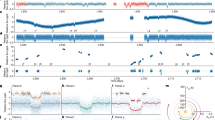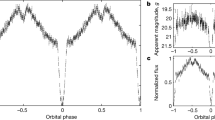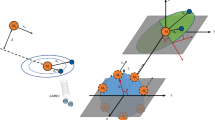Abstract
Most exoplanetary systems in binary stars are of S-type, and consist of one or more planets orbiting a primary star with a wide binary stellar companion1,2. Planetary eccentricities and mutual inclinations can be large3,4, perhaps forced gravitationally by the binary companion4,5,6. Earlier work on single planet systems5,7,8,9,10 appealed to the Kozai–Lidov instability11,12 wherein a sufficiently inclined binary orbit excites large-amplitude oscillations in the planet’s eccentricity and inclination. The instability, however, can be quenched by many agents that induce fast orbital precession, including mutual gravitational forces in a multiplanet system5,13. Here we report that orbital precession, which inhibits Kozai–Lidov cycling in a multiplanet system, can become fast enough to resonate with the orbital motion of a distant binary companion. Resonant binary forcing results in dramatic outcomes ranging from the excitation of large planetary eccentricities and mutual inclinations to total disruption. Processes such as planetary migration14,15 can bring an initially non-resonant system into resonance. As it does not require special physical or initial conditions, binary resonant driving is generic and may have altered the architecture of many multiplanet systems. It can also weaken the multiplanet occurrence rate in wide binaries, and affect planet formation in close binaries.
This is a preview of subscription content, access via your institution
Access options
Subscribe to this journal
Receive 51 print issues and online access
$199.00 per year
only $3.90 per issue
Buy this article
- Purchase on Springer Link
- Instant access to full article PDF
Prices may be subject to local taxes which are calculated during checkout



Similar content being viewed by others
References
Dvorak, R. Planetary orbits in double star systems. [in German] Oesterreichische Akademie Wissenschaften Mathematisch naturwissenschaftliche Klasse Sitzungsberichte Abteilung 191, 423–437 (1982)
Raghavan, D. et al. A survey of stellar families: multiplicity of solar-type stars. Astrophys. J. 190 (Suppl.), 1–42 (2010)
Tamuz, O. et al. The CORALIE survey for southern extra-solar planets. XV. Discovery of two eccentric planets orbiting HD 4113 and HD 156846. Astropart. Phys. 480, L33–L36 (2008)
Kaib, N. A., Raymond, S. N. & Duncan, M. J. 55 Cancri: a coplanar planetary system that is likely misaligned with its star. Astrophys. J. 742, L24 (2011)
Holman, M., Touma, J. & Tremaine, S. Chaotic variations in the eccentricity of the planet orbiting 16 Cygni B. Nature 386, 254–256 (1997)
Kaib, N. A., Raymond, S. N. & Duncan, M. Planetary system disruption by Galactic perturbations to wide binary stars. Nature 493, 381–384 (2013)
Wu, Y. & Murray, N. Planet migration and binary companions: the case of HD 80606b. Astrophys. J. 589, 605–614 (2003)
Fabrycky, D. & Tremaine, S. Shrinking binary and planetary orbits by Kozai cycles with tidal friction. Astrophys. J. 669, 1298–1315 (2007)
Lithwick, Y. & Naoz, S. The eccentric Kozai mechanism for a test particle. Astrophys. J. 742, 94 (2011)
Katz, B., Dong, S. & Malhotra, R. Long-term cycling of Kozai-Lidov cycles: extreme eccentricities and inclinations excited by a distant eccentric perturber. Phys. Rev. Lett. 107, 181101 (2011)
Kozai, Y. Secular perturbations of asteroids with high inclination and eccentricity. Astron. J. 67, 591 (1962)
Lidov, M. L. The evolution of orbits of artificial satellites of planets under the action of gravitational perturbations of external bodies. Planet. Space Sci. 9, 719–759 (1962)
Takeda, G., Kita, R. & Rasio, F. A. Planetary systems in binaries. I. Dynamical classification. Astrophys. J. 683, 1063–1075 (2008)
Malhotra, R. The origin of Pluto’s peculiar orbit. Nature 365, 819–821 (1993)
Murray, N., Hansen, B., Holman, M. & Tremaine, S. Migrating planets. Science 279, 69–72 (1998)
Gomes, R., Levison, H. F., Tsiganis, K. & Morbidelli, A. Origin of the cataclysmic Late Heavy Bombardment period of the terrestrial planets. Nature 435, 466–469 (2005)
Levison, H. F., Morbidelli, A., Gomes, R. & Backman, D. Planet migration in planetesimal disks. Protostars Planets V, 669–684 (2007)
Hahn, J. M. & Malhotra, R. Neptune’s migration into a stirred-up Kuiper belt: a detailed comparison of simulations to observations. Astron. J. 130, 2392–2414 (2005)
Lykawka, P. S., Horner, J., Jones, B. W. & Mukai, T. Origin and dynamical evolution of Neptune Trojans—I. Formation and planetary migration. Mon. Not. R. Astron. Soc. 398, 1715–1729 (2009)
Murray, C. D. & Dermott, S. F. Solar System Dynamics Ch. 7 (Cambridge Univ. Press, 1999)
Touma, J. R., Tremaine, S. & Kazandjian, M. V. Gauss’s method for secular dynamics, softened. Mon. Not. R. Astron. Soc. 394, 1085–1108 (2009)
Touma, J. & Wisdom, J. Resonances in the early evolution of the Earth–Moon system. Astron. J. 115, 1653–1663 (1998)
Ćuk, M. & Stewart, S. T. Making the Moon from a fast-spinning Earth: a giant impact followed by resonant despinning. Science 338, 1047–1052 (2012)
Chambers, J. E. A hybrid symplectic integrator that permits close encounters between massive bodies. Mon. Not. R. Astron. Soc. 304, 793–799 (1999)
Rein, H. A proposal for community driven and decentralized astronomical databases and the Open Exoplanet Catalogue. Preprint at http://arxiv.org/abs/1211.7121 (2012)
Poveda, A., Allen, C. & Hernández-Alcántara, A. in IAU Symposium (eds Hartkopf, W. I., Harmanec, P. & Guinan, E. F. ) Vol. 240, 417–425 (IAU, 2007)
Wang, J., Fischer, D. A., Xie, J.-W. & Ciardi, D. R. Influence of stellar multiplicity on planet formation. II. Planets are less common in multiple-star systems with separations smaller than 1500 au . Astrophys. J. 791, 111 (2014)
Wang, J., Xie, J.-W., Barclay, T. & Fischer, D. A. Influence of stellar multiplicity on planet formation. I. Evidence of suppressed planet formation due to stellar companions within 20 au and validation of four planets from the Kepler multiple planet candidates. Astrophys. J. 783, 4 (2014)
Rafikov, R. R. & Silsbee, K. Planet formation in stellar binaries. I. Planetesimal dynamics in massive protoplanetary disks. Astrophys. J. 798, 69 (2015)
Acknowledgements
We are grateful to S. Tremaine and the Institute for Advanced Study for hosting us in the early stages of our collaboration.
Author information
Authors and Affiliations
Contributions
J.R.T. and S.S. identified the process, developed and analysed mathematical models and wrote the paper and supplements. J.R.T. performed and analysed numerical experiments and produced all of the figures.
Corresponding author
Ethics declarations
Competing interests
The authors declare no competing financial interests.
Supplementary information
Supplementary Information
This file contains Supplementary Text and data, Supplementary References and Supplementary Figures 1–7. (PDF 2340 kb)
Rights and permissions
About this article
Cite this article
Touma, J., Sridhar, S. The disruption of multiplanet systems through resonance with a binary orbit. Nature 524, 439–441 (2015). https://doi.org/10.1038/nature14873
Received:
Accepted:
Published:
Issue Date:
DOI: https://doi.org/10.1038/nature14873
This article is cited by
-
Secular dynamics of multiplanetary circumbinary systems: stationary solutions and binary-planet secular resonance
Celestial Mechanics and Dynamical Astronomy (2018)
Comments
By submitting a comment you agree to abide by our Terms and Community Guidelines. If you find something abusive or that does not comply with our terms or guidelines please flag it as inappropriate.



